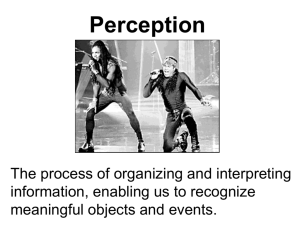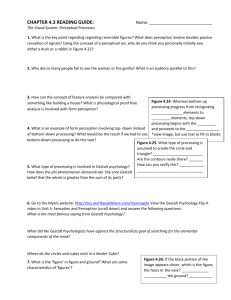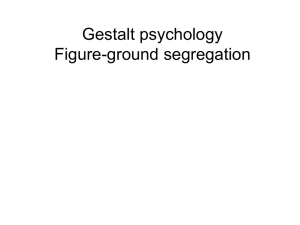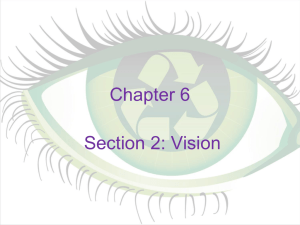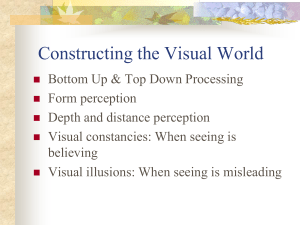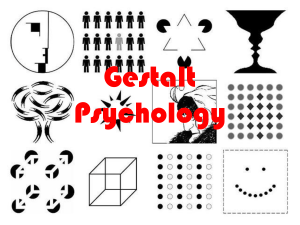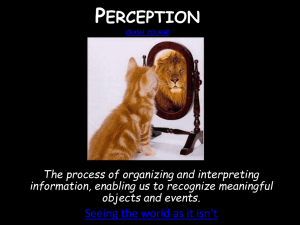Vision Part 2
advertisement
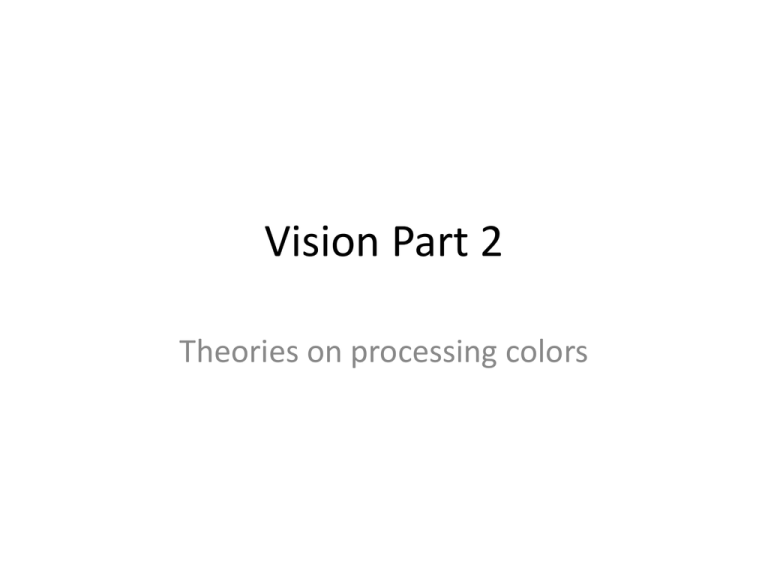
Vision Part 2 Theories on processing colors Objectives: The Student Will • • • • Compare and contrast color theories (VENN) Explain the Gestalt Theory List your Depth and Distance “cues” What is visual consistency? chapter 6 Sensation and perception How do we see color? • Trichromatic theory- theory of color perception Red, green, blue. • Pattern firing of 3 color receptors • Processes initial stages in the cone cells • Happens in retina, combination theory • cones in retina absent or malfunction= color blind OTOH • Opponent-process theory- Explains some color blindness and Negative Afterimages • Electromagnetic Energy= short wavelengths • Happens in ganglion cells, thalamus, visual cortex • Opponent process cells; cancel colors out chapter 6 Trichromatic theory Young (1802) and von Helmholtz (1852) both proposed that the eye detects 3 primary colors Red, blue, and green All other colors derived by combination chapter 6 Opponent-process theory A competing theory of color vision, which assumes that the visual system treats pairs of colors as opposing or antagonistic Opponent-process cells are inhibited by a color, and have a burst of activity when it is removed. chapter 6 Form perception Gestalt principles describe the brain’s organization of sensory building blocks into meaningful units and patterns. Gestalt Theory • Perceptual tricks: Blinking lights on Marquee • Gestalt Theory= Patterns in the brain • Gestalt means perceptual pattern or configuration in German. • Raw material of stimulation is sum of sensory parts • EQUATION chapter 6 Gestalt principles Proximity Things close to one another are grouped together Closure The brain tends to fill in gaps to perceive complete forms 2 principals • Proximity- Group things that are near each other • F.E. 3 groups of red dots not 12 individual dots or Blue vertical columns not horizontal rows • Closure: Makes you see incomplete figures as wholes by supplying the missing elements. • None of pictures complete chapter 6 Gestalt principles Similarity Things that are alike are perceived together Continuity Seeing continuity in lines that could be interpreted as either continuous or abruptly shifting in direction. 2 more Gestalt principals • Similarity- Group together things that have a similar look. • circles form X; See Horizontal stars because outlined or red • Continuity- we prefer smoothly connected and continuous figures to disjointed ones chapter 6 Your turn Which Gestalt principle is illustrated by the fact that we see columns of dots rather than rows in this diagram? 1. 2. 3. 4. Similarity Proximity Closure Continuity chapter 6 Your turn Which Gestalt principle is illustrated by the fact that we see columns of dots rather than rows in this diagram? 1. 2. 3. 4. Similarity Proximity Closure Continuity Depth and Distance Perception • Binocular convergence(need both eyes): How the lines of vision from each eye converge at different angles on objects at different distances • Put finger 6 in from face, move finger 1 foot back. Feel anything? • Binocular disparity: Different perspectives in each eye= different in retina either side • Finger 12 in. from face, alternate eyes • Gives us depth information chapter 6 Depth and distance perception Binocular cues: visual cues that require the use of both eyes Convergence Turning inward of the eyes, which occurs when they focus on a nearby object Retinal disparity The slight difference in lateral separation between two objects as seen by the right and left eyes Monocular Cues= 1 eye only • Relative size: objects in mirror closer than appear • Light and shadow: Bright=Closer; Dim=farther away • USED BY ARTISTS • Relative motion: Watch poles from car window, closer object the faster it seems to move • Interposition: Book obscures the background, stop sign in front if a car... Perceived as closer • Atmospheric perspective: haze or fog makes buildings look farther away chapter 6 Depth and distance perception Monocular cues: visual cues that can be used by one eye chapter 6 Visual constancies The accurate perception of objects as stable or unchanged despite changes in the sensory patterns they produce Shape constancy Location constancy Size constancy Brightness constancy Color constancy But apple red in kitchen and outside? • • • • Part sensory adaptation Adapt to bluish outside (short wave) Indoors long wave length Brain takes into account all wavelengths in visual field Visual illusions • Lines same length- Branches are perspective cues that suggest depth • A. 1889, German sociologist • B. one is like a near end of a building, other like far corner of room • Because if same size on retinal image, farther one away, farther one is larger one • Misinterprets information. chapter 6 The Müller-Lyer illusion chapter 6 Fooling the eye The cats in (a) are the same size. The diagonal lines in (b) are parallel. You can create a “floating fingertip frankfurter” by holding hands as shown, 5–10 inches in front of face. Summary • Color theories • Gestalt • Visual consistencies

